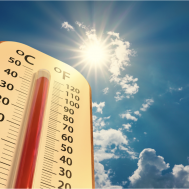With the summer season approaching and hot temperatures on the horizon, now seems like the perfect time to discuss rubber performance in high-temp environments. As such, it’s essential to know which materials work best in those scorching settings so you are informed on the best choice.
Heat’s Effects on Rubber
High temperatures can have many effects on rubber. For example, seal efficacy can be negatively impacted by rising temps; o-rings in prolonged heat will degrade chemically and physically, leading to hardening or swelling within the gland. This can cause a higher level of friction in dynamic applications. An o-ring constructed of materials with inferior heat resistance is more susceptible to failure over time.
Pressure is another factor to consider. Applications with high pressure are increasingly failure-prone because of the unreliability of the room temperature tests in those applications. The increased friction, as mentioned in the previous paragraph, is aggravated in high-pressure scenarios where a room-temperature test may not correctly predict performance. These tests, if not correctly accounting for high temperatures, can lead to irreversible chemical changes over time, causing increased seal hardness and compression set and volumetric changes.
Temperature Ranges by Material
Materials differ in their temperature ranges. Some compounds, like fluoroelastomers (FKM), fluorosilicone, and silicone can endure temperatures up to 400°F, with some able to have shorter-term exposure of up to 600°F. On the lower end of the temperature spectrum, ranging around 180°F and up to 300°F are natural rubber, nitrile (NBR), and EPDM. Environmental factors that can cause hot temperatures, like steam, should also be considered; a material like ethylene propylene can offer high resistance to steam.
High-Temperature Specialists
Let’s highlight two of the top high-temperature performers, silicone and FKM. Silicone is known as having one of the widest working temperature ranges for elastomers. Its static seals can work in extreme temperature situations of up to 400°F for standard and special compounds. FKM has high temperature resistance, with range for standard and special compounds at or above 400°F, depending on the use. For project needs, silicone or FKM should be considered for use in high-temp environments.
Applications in Action
High-temperature environments are standard in the automotive, industrial, and aerospace industries, respectively. In the automotive world, FKM and silicone rubber are used in car parts like gaskets and exhaust systems. For the systems used in industry, EPDM can be found in hoses and belts to help manufacturing run smoothly. The aerospace industry is similar to the automotive industry as FKM and silicone rubber are widely used, albeit in the typical high-temp situations of flight and takeoff.
Tips for Selecting a Material
There are a couple of practical things to keep in mind when selecting a heat-resistant material for a project. For starters, ensure you are working or will be working in a high-temperature environment, as incompatible seals can lead to problems down the line; you should also know if the environmental temperature will change or stay the same. Additionally, know how high the temperatures will be and make your material selection accordingly; if you know it may get up to 400°F, then FKM may be a better option than NBR.
Have more questions?
If you need help choosing a material, visit our Material Selection Guide page on our website to a professional guide. We recommend that, since no two situations are alike, to rigorously test the seal you select for your application before using it in production.
You can also reach out to us via our contact form!
